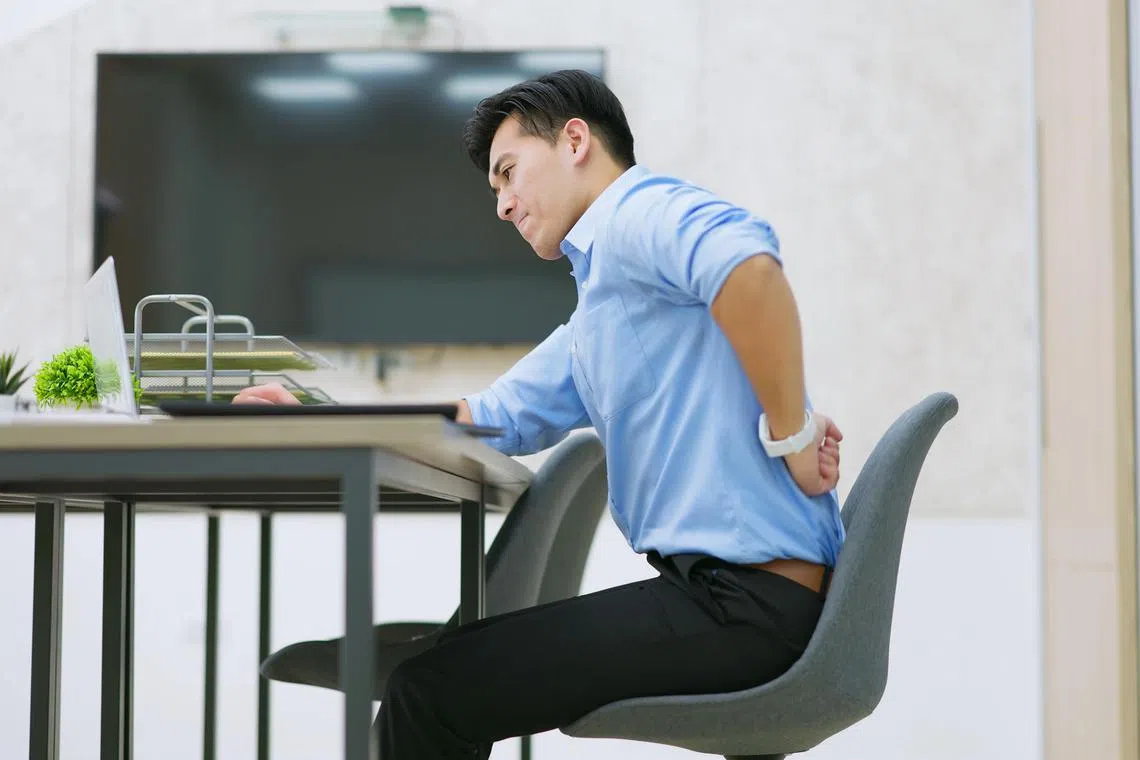Bad back: More teens and young adults in Singapore hit with degenerative disc disease
Sign up now: Get ST's newsletters delivered to your inbox

High-impact sports like football and repetitive movements like running can have an early wear and tear effect on the spinal discs.
PHOTO: ISTOCKPHOTO
Follow topic:
SINGAPORE – In her late 20s, Ms Jeslyn Ng began experiencing severe lower back pain and shooting pains down her left leg after caring for her late grandmother for a week.
Back then, in 2018, she had to carry her grandmother daily from the bed to the wheelchair and back.
The physical strain took its toll. “The pain in my back and leg started when I was resting one to two days after caring for her. Even passing stools became painful,” says Ms Ng, who is now in her mid-30s.
Simple tasks like sitting for more than five minutes and bending to reach for things became agonising for Ms Ng, a healthcare professional in a public hospital.
“I couldn’t tolerate driving, especially when I was caught in traffic jams,” she says.
For three months, she tried managing the pain with core strengthening exercises she found online, but they offered little relief.
So, she saw Dr Loo Wee Lim, then a consultant spine surgeon at Changi General Hospital.
Ms Ng was diagnosed with degenerative disc disease after a magnetic resonance imaging (MRI) scan.
The condition occurs when the soft discs between the bones in the spine wear out over time. These discs act like cushions, helping you to move, bend and twist comfortably as well as absorb shocks.
Dr Loo, now a consultant orthopaedic spine surgeon at Synergy Orthopaedic Group, prescribed her painkillers and anti-inflammatory medication and referred her to a physiotherapist.
Ms Ng attended physiotherapy sessions every three weeks for four months.
“The physiotherapist taught me exercises that strengthened my core and reduced my reliance on my back muscles. There was also advice on how to carry out my daily activities, in terms of being mindful of my posture when I’m sitting, standing and bending to reach for things on the ground,” she says.
Over time, she also incorporated pilates into her routine, which improved her core strength and posture. Gradually, she learnt to manage her condition.
High-impact sports, poor posture linked to early onset of condition
Degenerative disc disease was once considered an ailment of people in their 50s and 60s.
It is increasingly affecting younger people in Singapore, including teenagers from age 16, says Dr Tan Jun Hao, an associate consultant at National University Health System’s National University Spine Institute.
Dr Loo sees many people aged 18 to 35 with neck and lower back pain arising from degenerative disc disease. By age 35, one in three individuals will show signs of the disease on imaging scans, he notes.
He adds that genetics, obesity and excessive physical stress, such as carrying heavy backpacks or overly intense exercise, can contribute to early onset of degenerative disc disease.
“Due to the increasing popularity of Hyrox and CrossFit, more young adults are engaging in demanding physical activities. Some of them are not conditioned properly and have weak core body strength, thus subjecting them to early development of degenerative disc disease,” says Dr Loo.
High-impact sports, like basketball and football, and repetitive movements, like running or rope jumping, can cause constant abnormal loading of the spinal discs.
As the discs are meant to be a cushion for pressure on the spine, constant repetitive loading forces can have an early wear and tear effect on them, says Dr Loo.
Dr Foo Gen Lin, a consultant orthopaedic surgeon at Apex Sports Clinic, sees 80 to 100 patients with degenerative disc disease a year. Of these, eight to 20 range from teenagers to those in their 30s.
Poor posture and a sedentary lifestyle are also risk factors for spine issues such as degenerative disc disease.
“Prolonged sitting or standing with poor posture leads to muscle fatigue and strain, which compound the unhealthy forces that act on the spine,” says Dr Foo.
The growing use of mobile devices and computers has also worsened the impact of poor posture and repetitive movements, he adds.
Dr Loo says studies have shown that young adults who spend a significant amount of time with their spine curved forward are at higher risk of disc degeneration.
Heavy smokers and those with injuries to the back are also at higher risk of developing degenerative disc disease, says Dr Tan.
He explains that smoking reduces blood flow, affecting the discs, which rely on a healthy blood supply for nutrients and hydration. When blood flow is restricted, the discs lose their ability to repair and maintain themselves, leading to degeneration.
Pain can be debilitating
The most common symptom of the condition is back pain, say doctors.
The pain may worsen when the person is in certain positions and postures, says Dr Tan. It may also intensify after carrying heavy objects, or when participating in strenuous sports and activities that require forward bending of the lower back.
Anyone who has experienced the pain can relate to how debilitating it can be, says Dr Foo.
“Simple things that we take for granted, like getting out of bed and bending down to put on one’s shoes, can be very difficult and painful,” he adds.

Mrs Gagan Preet Kaur was 44 years old when she found out she has degenerative disc disease.
ST PHOTO: JASON QUAH
Make-up artist Gagan Preet Kaur found out in 2020 that she has degenerative disc disease.
“I was shocked because I thought this ‘wear and tear’ condition happens to people who are much older,” she says.
Before she saw a doctor at Singapore General Hospital (SGH), she had lower back pain when she did forward-bending yoga postures and weightlifting.
“The pain would come and go, and I felt it wasn’t normal,” says the 48-year-old, who is married and has three children.
After the diagnosis, she underwent physiotherapy at SGH for a few months, which initially alleviated her pain. Gradually, she resumed her exercise routine, but earlier in 2024, the pain returned.
It became so severe that she had to stop workouts which involved exercises like deadlifts and Cuban presses with a barbell. Painkillers provided no relief.
In August, she saw her doctor again. This time, the MRI showed her degenerative disc disease had worsened. She will be resuming physiotherapy.

The bird dog stretch is one of the exercises that help Mrs Gagan Preet Kaur manage her lower back pain.
ST PHOTO: JASON QUAH
Dr Foo says those with more serious degeneration can have nerve impingement, which can cause radiating pain, such as sciatica, where pain travels from the buttocks down the leg, as well as numbness or weakness that affects the upper or lower limbs.
In some cases, the compression of the spinal cord can cause more serious symptoms like urinary or bowel incontinence, he adds.
However, not everyone with degenerative disc disease will experience pain. Most people who have the condition lead a normal and healthy lifestyle without physical restrictions, says Dr Loo.
Lower back pain is common in physically active individuals, with most cases due to a muscular strain or contusion. But Dr Loo advises seeing a doctor if the pain persists for more than four weeks, despite adequate rest and taking pain-relief medication.
Now, Ms Ng experiences lower back pain three to four times a month, and the episodes are usually short and vary in nature.
Sometimes, she feels the pain as soon as she wakes up, while at other times, it occurs when she walks or stands for more than an hour in a day.
The pain, however, does not last as long as it did initially. Now, it often subsides within a few minutes, especially after resting.
If the pain becomes persistent or severe, she takes painkillers. She needs them about once every three months.
Dr Loo says most young adults with degenerative disc disease do not require surgery.
During episodes of severe pain, taking painkillers and wearing a back brace for a short period of time may be helpful, says Dr Tan.
Physiotherapy helps
Mr Douglas Koh, a physiotherapist at SGH, says physiotherapy can play an important role in managing pain associated with degenerative disc disease.
A treatment plan includes exercises to improve flexibility, which can reduce pain resulting from joint and muscle stiffness, and hence increase mobility of the spine. These may include the knee-to-chest stretch while lying down and the cat-cow stretch.
Strengthening the muscles around the spine and adjacent joints can also help support the spine and reduce strain on the neck and back, says Mr Koh.
“Physiotherapists may also guide patients in gradually reintroducing movements they may have avoided due to pain, while incrementally increasing activity levels,” he adds.
A key part of long-term self-management of the condition is providing patients with knowledge about aspects such as body mechanics, activity modifications and ways to prevent flare-ups, he notes.
This is coupled with education on appropriate lifting techniques for heavier objects, ergonomics in sitting or standing, as well as addressing misconceptions and fear avoidance behaviours.
Dr Loo says low-impact activities like swimming can alleviate symptoms associated with the condition.
Applying cold or hot packs can minimise inflammation and relieve back tension, he adds.
Dr Foo advises his patients who sit or stand for prolonged periods to set an alarm for breaks every 30 to 45 minutes. During these breaks, they should do simple exercises such as chair squats and back stretches.
Says Dr Loo: “Ensure your home or workspace is ergonomically designed to support your spine. Having a work chair with an adjustable height and lumbar support can go a long way in preventing the condition.”
To avoid degenerative disc disease, Dr Tan suggests doing adequate stretching exercises before lifting heavy weights or doing high-impact sports. He also advises maintaining a good posture, avoiding smoking and maintaining a healthy weight.
While no food or supplement can reverse disc degeneration, Dr Loo says many foods support spinal health. Dairy products like milk, cheese and yogurt are rich in calcium, which is essential for strong bones, including the spine.


